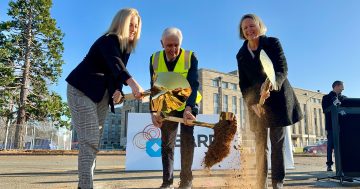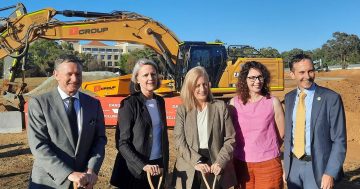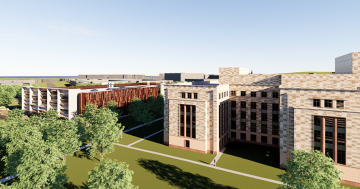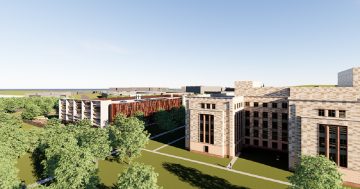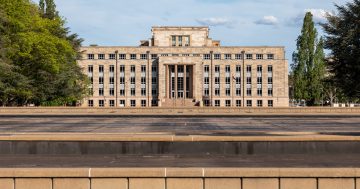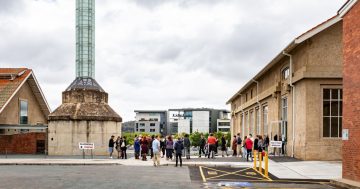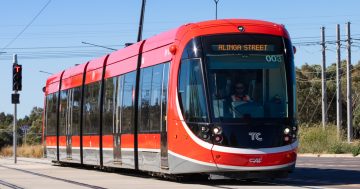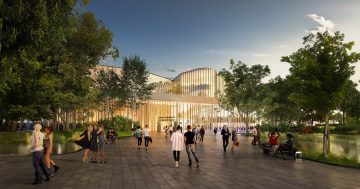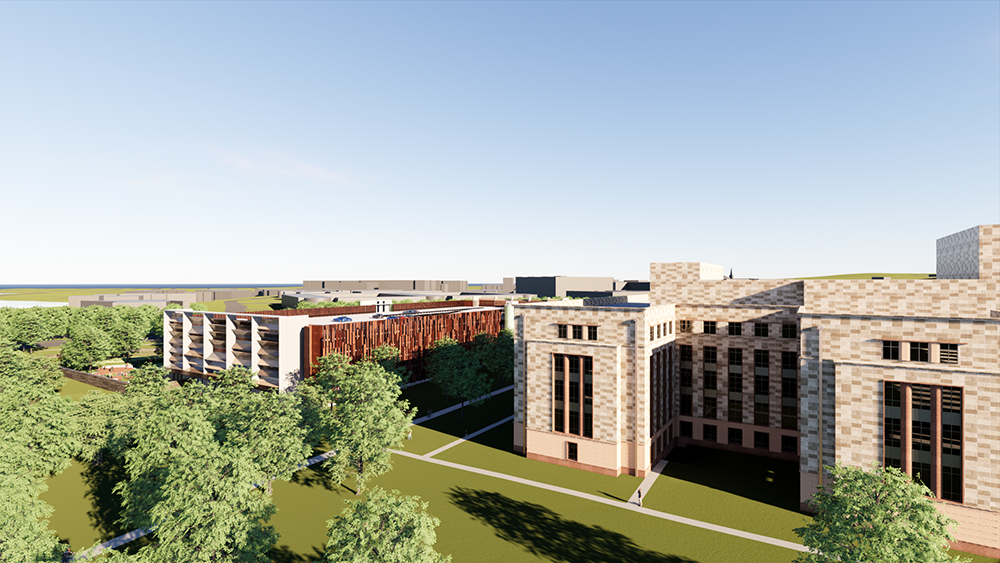
A concept illustration of the car park to be built next to the John Gorton Building as part of the National Security Precinct project. Photo: Department of Finance.
What’s Barton got to make it a development hot spot for government?
That’s what the burghers of Canberra’s Town Centres and Civic must be asking after the latest Federal Government announcement of a National Security Precinct to be built there, on the giant car park opposite DFAT’s RG Casey Building.
Block 5, Section 1 is a prime spot on the corner of State Circle and Brisbane Avenue near Parliament House next to York Park, and yes, it will be on the light rail line to Woden at some point in the future, but no one can say when.
The Budget did not list the cost but said 5000 staff will be calling the precinct home by the end of the decade.
Industry speculation is that the government has budgeted a conservative $1.5 billion for the project, which could entail five buildings and 100,000 square metres of floor space.
There was little information available on Budget night, but now the Department of Finance has posted a summary of the project on its website, complete with a Q&A.
A Finance Department spokesperson says the Precinct and associated infrastructure will have a number of public and private tenants and is expected to be occupied by a range of Commonwealth entities including the Office of National Intelligence and parts of the Department of Foreign Affairs and Trade.
Finance says scoping with the National Capital Authority identified the Commonwealth-owned York Park site as suitable for a multi-agency precinct in an area it says was designated for government offices, although many tenants in Barton are national organisations and lobby groups.
Tenants will be confirmed after the completion of detailed planning and functional design work, which is expected in mid-2023.
“The Precinct will provide enhanced public amenities to the wider Barton area and include a mix of retail, hospitality and services that have the potential to be active day and night,” the spokesperson said.
“The type and number of commercial services will be determined during the future design phase, but is likely to include cafes, restaurants, a gym and some retail.”
The first stage won’t be on the Barton site but the John Gorton Building car park in nearby Parkes, where a multi-storey car park and public amenities, including a 170-place child-care centre will be built.
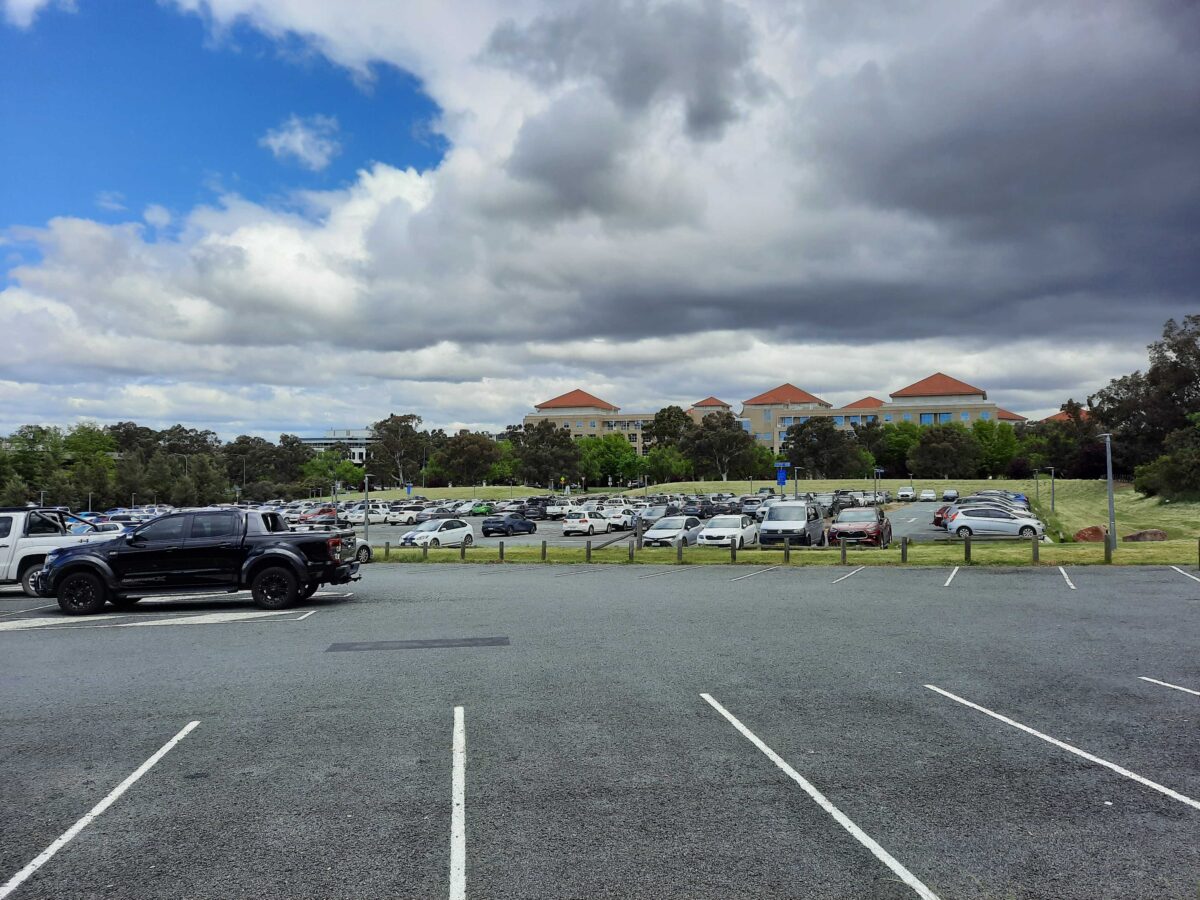
The York Park car park opposite DFAT’s RG Casey Building is the site for a National Security Precinct. Photo: Region.
It will replace displaced car parking on the York Park site and support worker and visitor amenities, including for nearby cultural institutions such as the National Gallery of Australia, the National Portrait Gallery and the future Ngurra Cultural Precinct.
A Works Approval application is expected to go to the NCA in early 2023.
Its construction is due to start in mid-2023 with completion in late 2024, while the York Park Precinct will commence early in 2025.
At the same time, there is a clutch of new office buildings about to go up nearby to house other government agencies in Barton, including the six-storey Cromwell site at 19 National Circuit, the proposed new six-storey Tax Office site at 15 Sydney Avenue and Willemsen’s eight-storey proposal at 10 Brisbane Avenue.
It is also believed that the Department of Infrastructure now has Barton in its sights after it was rumoured that it would go to One City Hill in Civic.
The result will be many thousands of new workers in an area that currently lacks the infrastructure to support them.
This repositioning of government resources and transformation of Barton into a commercial centre comes as the Town Centres, which do have the infrastructure and services for such a workforce, are crying out for more jobs.
The new Precinct is being sold as a big win for Canberra, with massive investment in the APS and thousands of construction jobs to be created in the process. Although where they are all going to come from with so many concurrent projects – and let’s not forget the government offices to be built on the law courts car park in Civic, light rail Stage 2A, the Woden CIT and the Canberra Hospital expansion – all competing for workers is a mystery.
Labor promised to reinvest in the public service and rebuild its capacity, but most would have thought of services, not a rush of shiny new buildings, particularly with an economy in crisis and people facing rising mortgages and energy bills.
To be fair, this project began under the Morrison Government, and it won’t be until there is some Parliamentary scrutiny of it or public release of plans for approvals that we will better understand all the motivation for it beyond the obvious international security situation and cyber vulnerabilities, or the decision to site it in Barton.
Finance says the project needs to happen now because agencies are reaching or at capacity within their existing offices, which are not fully fit for purpose and do not have room for future growth.
Earlier talk of a national security precinct was directed across the lake along Constitution Avenue where the new defence-orientated UNSW campus will be built on the CIT site in Reid, with potential links to ASIO and Defence in Russell.
That seemed to make sense.
But there are smaller DFAT leases in the city that will probably be consolidated on the site close to the Casey building, and the Office of National Intelligence is already in Barton.
Proximity to Parliament House has also been given as a reason for Barton’s popularity, but that is not particularly compelling.
The other question is: how will these thousands of workers get into and out of Barton every day?
The place is going to be a construction site for five or (likely) more years, so for those already in Barton, commuting and parking are going to be a nightmare, even with the new car park to be built next to the John Gorton Building.
The raising of London Circuit and then the laying of tracks for light rail Stage 2A to Commonwealth Park will bring years of traffic disruptions to the southern gateway to the city and diversions to the already at-capacity Kings Avenue Bridge.
And when the Precinct is built, along with all the other projects, the small city population of New Barton will still be grappling with an overwhelmed road network and, the ACT Government assures us, the construction of the next stage of light rail across the lake and around State Circle to Woden.
At least if the federal government wants to create such a concentration of its workers in one area, it can hardly deny the progress of light rail past it.
The ACT Government will argue the Barton project can only firm up the viability of light rail stage 2B, but just when that will happen is anybody’s guess.
In the meantime, it’s the car, the bus or the bike, and no doubt all of the new A-grade, highly sustainable buildings will come with end-of-trip facilities.
Overall, it will be good for Canberra because what’s good for the APS generally is, but it won’t come without some downsides and there are questions that need answering.
One can’t also help thinking that with the nation confronting so many challenges, including a housing crisis, is it the right time for the APS to be so focused on a set of new palaces in the national capital?












